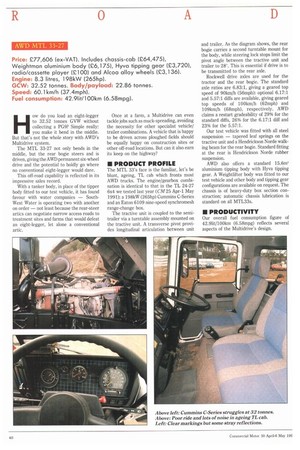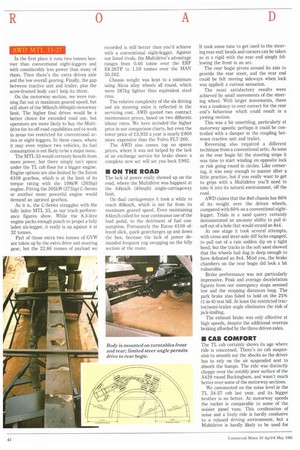Price: £77,606 (ex-VAT). Includes chassis-cab (£64,475), Weightman aluminium body (£6,175),
Page 42

Page 44

Page 45

If you've noticed an error in this article please click here to report it so we can fix it.
Hyva tipping gear (£3,720), radio/cassette player (£100) and Alcoa alloy wheels (£3,136). Engine: 8.3 litres, 198kW (265hp).
GCW: 32.52 tonnes. Body/payload: 22.86 tonnes.
Speed: 60.1km/h (37,4mph).
Fuel consumption: 42.91it/100km (6.58mpg).
How do you load an eight-legger to 32.52 tonnes GVW without collecting a PG9? Simple really: you make it bend in the middle. But that's not the whole story with AWD's Multidrive system.
The MTL 33-27 not only bends in the middle, but the rear bogie steers and is driven, giving the AWD permanent six-wheel drive and the potential to boldly go where no conventional eight-legger would dare.
This off-road capability is reflected in its impressive sales record.
With a tanker body, in place of the tipper body fitted to our test vehicle, it has found favour with water companies — SouthWest Water is operating two with another on order — not least because the rear-steer artics can negotiate narrow access roads to treatment sites and farms that would defeat an eight-legger, let alone a conventional artic. Once at a farm, a Multidrive can even tackle jobs such as muck-spreading, avoiding the necessity for other specialist vehicle/ trailer combinations. A vehicle that is happy to be driven across ploughed fields should be equally happy on construction sites or other off-road locations. But can it also earn its keep on the highway?
• PRODUCT PROFILE
The MTL 33's face is the familiar, let's be blunt, ageing, TL cab which fronts most AWD trucks. The engine/gearbox combination is identical to that in the TL 24-27 6x4 we tested last year (CM 25 Apr-1 May 1991): a 198kW (265hp) Cummins C-Series and an Eaton 6109 nine-speed synchromesh range-change box.
The tractive unit is coupled to the semitrailer via a turntable assembly mounted on the tractive unit. A transverse pivot provides longitudinal articulation between unit and trailer. As the diagram shows, the rear bogie carries a second turntable mount for the body, while steering lock stops limit the pivot angle between the tractive unit and trailer to 28°. This is essential if drive is to be transmitted to the rear axle.
Rockwell drive axles are used for the tractor and the rear bogie. The standard axle ratios are 6.83:1, giving a geared top speed of 901un/h (56mph): optional 6.17:1 and 5.57:1 diffs are available, giving geared top speeds of 100km/h (62mph) and 109km/h (68mph), respectively. AWD claims a restart gradeability of 29% for the standard diffs, 26% for the 6.17:1 diff and 23% for the 5.57:1.
Our test vehicle was fitted with all steel suspension — tapered leaf springs on the tractive unit and a Hendrickson Norde walking beam for the rear bogie. Standard fitting at the rear is Hendrickson Norde rubber suspension.
AWD also offers a standard 15.6m3 aluminium tipping body with Hyva tipping gear. A Weightlifter body was fitted to our test vehicle and other body and tipping gear configurations are available on request. The chassis is of heavy-duty box section construction; automatic chassis lubrication is standard on all MTL33s.
• PRODUCTIVITY
Our overall fuel consumption figure of 42.91it1100km (6.58mpg) reflects several aspects of the Multidrive's design. In the first place it runs two tonnes heavier than conventional eight-leggers and with considerably less power than many of them. Then there's the extra driven axle and the low overall gearing. Finally, the gap between tractive unit and trailer, plus the scow-fronted body can't help its thirst.
On the motorway section, we were running flat out at maximum geared speed, but still short of the 96km/h (60mph) motorway limit. The higher final drives would be a better choice for extended road use, but operators are more likely to buy the Multidrive for its off-road capabilities and to work in areas too restricted for conventional artics or eight-leggers. In these cases, where it may even replace two vehicles, its fuel consumption is not likely to be a major issue.
The MTL 33 would certainly benefit from more power, but there simply isn't space under the TL cab floor for a bigger engine. Engine options are also limited by the Eaton 6109 gearbox, which is at the limit of its torque rating with the 198kW (265hp) engine. Fitting the 205kW (275hp) C-Series or another more powerful engine would demand an uprated gearbox.
As it is, the C-Series struggles with the fully laden MTL 33, as our track performance figures show. While the 8.3-litre engine packs enough punch to propel a fully laden six-legger, it really is up against it at 32 tonnes.
Part of those extra two tonnes of GVW are taken up by the extra drive and steering gear, but the 22.86 tonnes of payload we recorded is still better than you'd achieve with a conventional eight-legger. Against our listed rivals, the Multidrive's advantage ranges from 0.46 tonne over the ERF E8.26TP to 1.59 tonnes over the MAN 30.262.
Chassis weight was kept to a minimum using Alcoa alloy wheels all round, which were 287kg lighter than equivalent steel rims.
The relative complexity of the six driving and six steering axles is reflected in the servicing cost. AWD quoted two contract maintenance prices, based on two different labour rates. We have included the higher price in our comparison charts, but even the lower price of £5,932 a year is nearly £900 more expensive than the Volvo FL7-260.
The AWD also comes top on spares prices, where it was not helped by the lack of an exchange service for brake shoes: a complete new set will set you back £992.
• ON THE ROAD
The lack of power really showed up on the road, where the Multidrive was happiest at the 641on/h (40mph) single-carriageway Limit.
On dual carriageways it took a while to reach 80km/h, which is not far from its maximum geared speed. Even maintaining 64km/h called for near continuous use of the loud pedal, to the detriment of fuel consumption. Fortunately the Eaton 6109 offered slick, quick gearcharges up and down the box, because the lack of power demanded frequent cog swapping on the hilly section of the route. It took some time to get used to the steering rear end: bends and corners can be taken as in a rigid with the rear end simply following the front in an arc.
The rear bogie pivots around its axis to provide the rear steer, and the rear end could be felt moving sideways when lock was applied: a curious sensation.
The most satisfactory results were achieved by small movements of the steering wheel. With larger movements, there was a tendency to over correct for the rear end's behaviour which could result in a yawing motion.
This was a bit unsettling, particularly at motorway speeds; perhaps it could be controlled with a damper in the coupling between tractive unit and trailer.
Reversing also required a different technique from a conventional artic. As soon as the rear bogie hit the steering stops it was time to start winding on opposite lock or risk going round in circles. Like cornering, it was easy enough to master after a little practice, but if you really want to get to grips with a Multidrive you'll need to take it into its natural environment, off the road.
AWD claims that the 8x6 chassis has 86% of its weight over the driven wheels, compared with 60% on a conventional eightlegger. Trials in a sand quarry certainly demonstrated an uncanny ability to pull itself out of a hole that would strand an 8x4.
At one stage it took several attempts, with cross and inter-axle diff locks engaged, to pull out of a rain sodden dip on a tight bend, but the tracks in the soft sand showed that the wheels had dug in deep enough to have defeated an 8x4. Mind you, the brake chambers on the rear bogie did look a bit vulnerable.
Brake performance was not particularly impressive. Peak and average deceleration figures from our emergency stops seemed low and the stopping distances long. The park brake also failed to hold on the 25% (1-in-4) test hill. At least the restricted tractor/semi-trailer angle eliminates the risk of jack-knifing.
The exhaust brake was only effective at high speeds, despite the additional overrun braking afforded by the three driven axles.
• CAB COMPORT
The TL cab certainly shows its age where ride is concerned. There's no cab suspension to smooth out the shocks so the driver has to rely on the air suspended seat to absorb the bumps. The ride was distinctly choppy over the notably poor surface of the A429 round Buckingham, and wasn't much better over some of the motorway sections.
We commented on the noise level in the TL 24-27 cab last year, and its bigger brother is no better. At motorway speeds the racket is comparable to some of the noisier panel vans. This combination of noise and a lively ride is hardly conclusive to a relaxed driving environment, but a Multidrive is hardly likely to be used for long-haul work, and the cab is well suited to tipper work.
The deep rear shelf offers plenty of stowage space with more in the headlining, including a radio mounting point. The cab comes with a dual passenger seat and crosscab access is good with the engine set back beneath the seats.
Rubber floor mats should make it easy to keep clean and the grey trim combines with blue seat covering to make a pleasing contrast.
Controls and instruments are the same as in the TL 24-27, so the criticisms we made in that test still apply: the tacho glass produces stray reflections and intermittent wiper control entails switching the wipers on then off; repeating the process to switch it off.
Visibility is good, with an effective heater and ventilation supplemented by opening quarterlights. Heated mirrors help in rain and misty conditions and the rear windows improve rear three-quarter vision. But, just like the TL 24-27, the kerb mirror is set too high and can be obscured by a passenger's head.
• SUMMARY
Comparison with conventional eight-leggers is only valid to a point. They offer a better compromise between on and off-road work, and from next year they'll even be able to match the Multidrive's GVW, as long as they're running on road friendly suspension.
But when it comes to tackling arduous terrain no 8)(4 can keep up with a Multidrive. If your operation involves extensive work off-road or in very hilly country, the extra cost starts to make sense.
Most of the AWD's shortcomings are linked to its ageing tractive unit. The lack of space beneath the cab restricts the choice of engine and gearbox, while the lack of cab suspension and the high noise levels detract from its driver appeal. This can make it feel like an off-road vehicle designed with occasional on-road use in mind.
It needs the added comfort of a more modern cab to improve its on-road appeal, and there are Multidrives around with Volvo and Leyland Daf front ends.
Compared with your average 8x4, the Multidrive's Z64,475 (ex-VAT) price tag is a big one. Only a top price chassis like the IFT Maggie 300.34 (t63,056 ex-VAT) comes close. But, as with any specialist vehicle, if you need what it has to offer you won't be put off by its price, and as some operators have found, in some roles the Multidrive is literally in a field of its own.
0 by John Kendall
















































































































